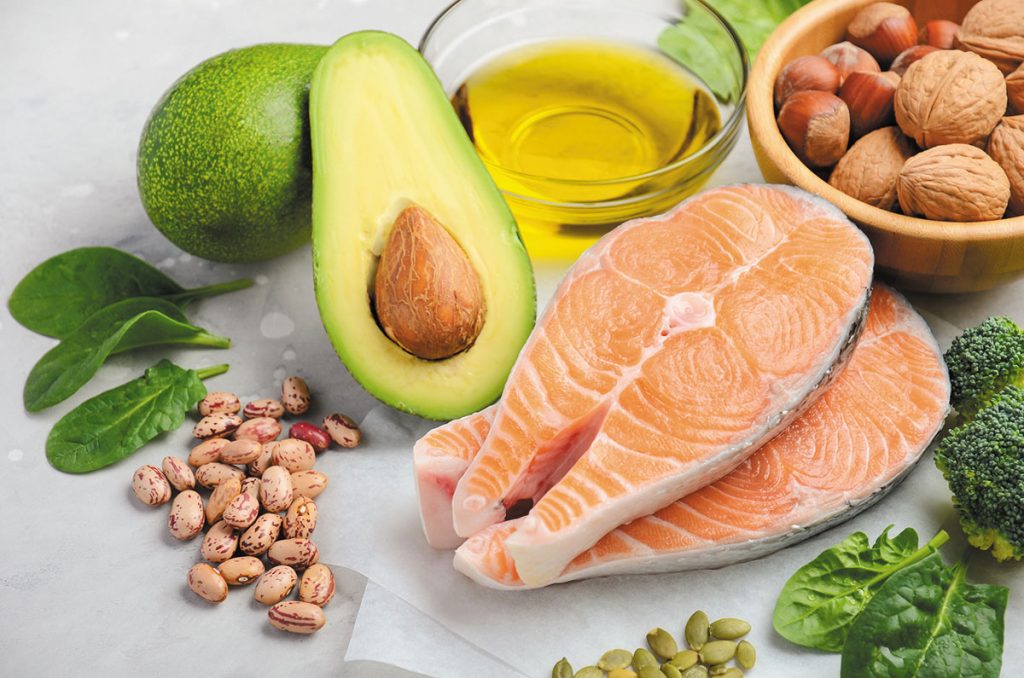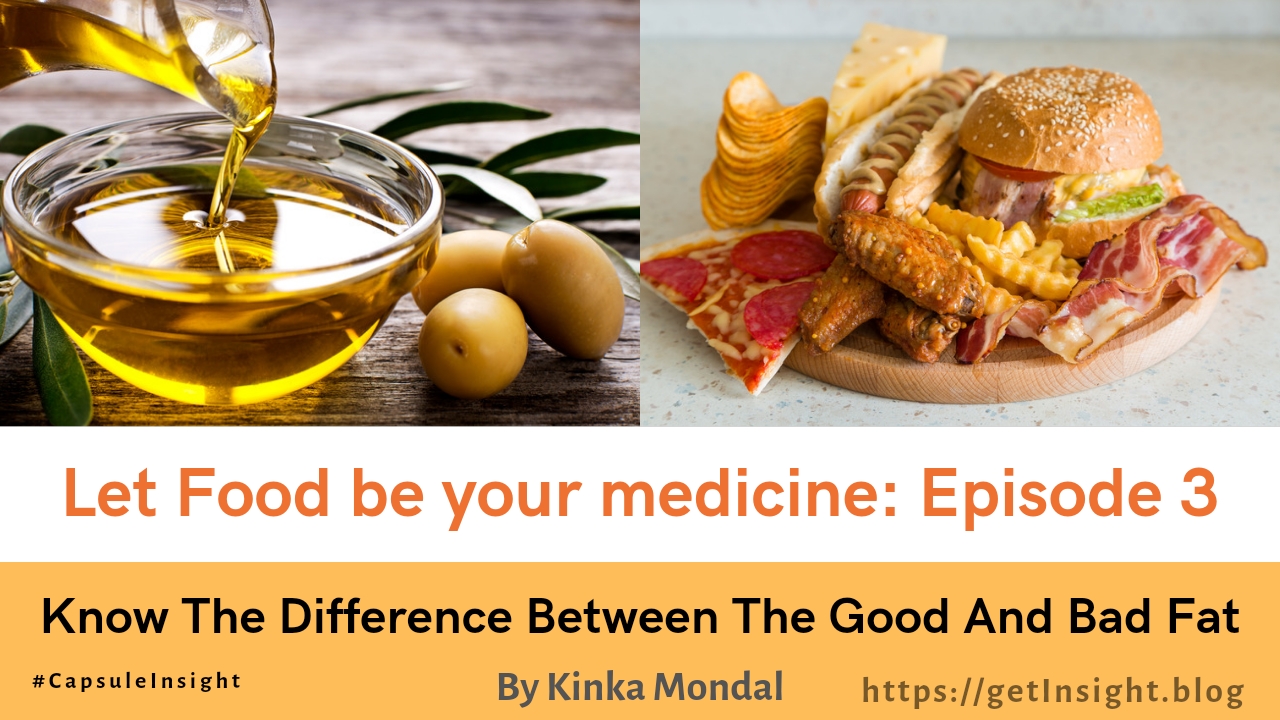As per our preconceived notion we have categorized fat as the most harmful, and useless nutrient ever. This article is specifically to break that prejudice about fats and understand rather its health benefits. Also, identify the “Good” fats over the “Bad” ones.

What is fat?
In simple words, fat is one of the food constituents like carbohydrates and proteins , but it differs in chemical structure. Fats are greasy , smooth substances that are insoluble in water. Fat is the main source of fuel for us. One gram of fat contributes 9.3Kcal units of energy, that is more than twice what carbohydrate and protein contribute individually.
What are the roles of fat?
The general idea is fat only causes harms to our body, so before anything discard this from foods!! if you think in this same way, YOU NEED TO READ THIS ARTICLE!
First thing first, let’s understand the benefits of fats one by one:
Major source of energy:
As mentioned before, fat gives the major part of the energy. Fat is stored in the adipose tissues which serve as the energy store of the body. One pound (454gm) of stored fat can represent 3500 kcal of stored energy. The body fat content of 15-18% in case of males and 18-24% in females of the total bodyweight is considered to be the normal.
Body function regulation:
Fat is an essential component of cell membranes, thus it creates passage for materials to be in or out from the cells. There are polyunsaturated fatty acids which help as the precursors of several hormone like substances in the body, example: prostaglandin which participates in many important physiological roles. (But over production of such substances can lead to adverse reactions,)

Carrier of Fat-soluble Vitamins:
Fat-soluble vitamins, like Vitamin- A, D, E, and K are carried to their destinations by the fats. In case of dietary deficiency of fats, absorption of such vitamins get hampered, thus several metabolisms also get affected.
Protect Organs:
Organs, like Kidney, heart are protected by a wall of fat tissue. Thus, these vital organs can easily overcome any physical shock and positioned in actual place.
Normal Insulator:
Subcutaneous fats in the body help to keep body warm, thus protect from extreme cold weathers. A certain minimum level of fat layer is important for everyone.
Increase satiety Value:
Fats take time to get digested completely. It gives stomach a sense of fullness, so a certain amount of fats in diet is necessary to control the feeling of hunger. It is to be noted that, this is the reason that nowadays, incorporation of fat in weight-reduction diet is more acceptable that a diet without or very less amount of fats.
Enhance Palatability of foods:
Fats help to increase taste of foods. there are so many substances which are the responsible for taste are fat-soluble. Thus, frying foods increase palatability of foods.
What are the GOOD and BAD fat?
There are mainly two broad classification of fats. Bad fats are made up of saturated fatty acids, found abundantly in animal foods, like- red meat, milk products – cheese, margarine, processed foods, fast foods- burger, pizza, hamburgers etc. There are another kind of moderately hydrogenated trans fats , found in fried fast foods, refrigerated dough products, canned foods, bakery foods etc.
On the other hand, Good fats are unsaturated fatty acids, there are again mono-unsaturated and poly-unsaturated fatty acids chains which further adds goodness to fats. Mono-unsaturated fatty acids (MUFA) are found in avocadoes, peanut butter, nuts, like cashew, almonds, seeds, like pumpkin seeds, sunflower seeds etc.

Poly-Unsaturated fatty acids (PUFA) includes Omega-3 and Omega-6 fatty acids, which are very important for brain functions, but body can not produce those fatty acids, thus required amount of these good fat should be incorporated in daily meals. PUFA is found in greater amount in sea fish, like- salmon, herring, in vegetable oils, like- soybean oils, safflower oil, grapeseed oil and flaxseed oils.
Addition of good fat ensures good health overall, whereas, inclusion of bad fat to diet can trigger several health issues as they can increase the LDL (Low Density Lipoprotein) in blood. Saturated and trans fats should be avoided to avoid diseases.
How much fat one should include in diet?
For every individual the requirement of dietary fats is different. It depends on age, gender, body weight and other important matter. As per Indian RDA (Recommended Dietary Allowances), a healthy individual should have 20-35% of total calories from fats daily. Though, in certain age group or in health conditions , like- heart diseases, diabetes or obesity, the amount of fat consumption can vary and should be advised by health professionals.
What happens when you discard all dietary fats?
If one discards fat from diet, it can lead to conditions, like:
1. Dry and rough scaly skin
2. Dry hair
3. Loss of hair
4. Dry eyes
5. Feeling of cold
6. Feeling hungry
7. Deficiency of several hormones
8. Deficiency in Fat-soluble vitamins (A,D, E, K)
At the end of this article, it is very important to mention that our body requires each and every component to function normally. We should not haphazardly include or discard such components without proper guidelines from the experts, otherwise it may harm our body. As you can understand now fat is not bad always. But careful selection of good fat can help to maintain an overall good health.
As this entire “Let Food be Your Medicine” is dedicated to make people aware about goodness of foods and breaking the barriers of deep-rooted taboos, you can find other articles on this series :
here:https://getinsight.blog/let-food-be-your-medicine-know-the-terms-1st-episode/
https://getinsight.blog/know-basics-about-immunity-system-and-foods-as-immunity-booster/
REFERENCES:
B. Srilakshmi, Nutrition Science
Norman N. Potter , Food Science

